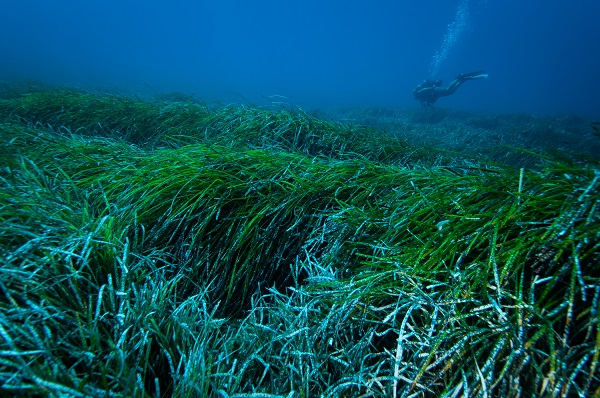Jan 15 2021
A new study has reported that Posidonia oceanica seagrass—a kind of endemic marine phanerogam that plays a crucial ecological role in the marine environment—can trap and eliminate plastic materials abandoned at the sea.
 This natural mechanism could trap about 867 million plastic per year in coastal areas. Image Credit: Jordi Regàs.
This natural mechanism could trap about 867 million plastic per year in coastal areas. Image Credit: Jordi Regàs.
The first author of the study, which was published in the Scientific Reports journal, is the tenure-track 2 lecturer Anna Sànchez-Vidal, who is part of the Research Group on Marine Geosciences of the Faculty of Earth Sciences of the University of Barcelona (UB).
For the first time, the study shows how the Posidonia plays a crucial role by filtering and trapping plastics found in the coastal regions and is the first-ever study to describe how a natural mechanism takes and eliminates such materials from the sea.
The other authors of the study are Miquel Canals, William P. de Haan, and Marta Veny, all experts from the Research Group on Marine Geosciences of the UB, and also Javier Romero from the Faculty of Biology and the Biodiversity Research Institute (IRBio) of the UB.
A Trap for Plastics in Coastal Areas
The Posidonia oceanica creates thick prairies that make a habitat with a significant ecological value (reproduction, shelter, nutrition, etc.) for the biodiversity of marine animals. In this research, the investigators examined the trapping and removal of plastic in the great Posidonia seagrasses found on the coasts of Majorca.
Everything suggests that plastics are trapped in the Posidonia seagrass. In the grasslands, the plastics are incorporated to agglomerates of natural fiber with a ball shape—aegagropila or Posidonia Neptune balls—which are expulsed from the marine environment during storms.
Anna Sànchez-Vidal, Member, Department of Ocean and Earth Dynamics, University of Barcelona
“According to the analyses –she continues- the trapped microplastics in the prairies of the Posidonia oceanica are mainly filaments, fibers and fragments of polymers which are denser than the sea water such as polyethylene terephthalate (PET),” added Sànchez-Vidal.
How are Posidonia Neptune Balls Made?
This kind of marine phanerogam has a vegetative structure created by a modified rhizome-shaped stem from which the leaves and roots arise. As the leaves fall, its bases or pods are added to rhizomes and provide them with a feather-like look.
As a result of the mechanical erosion in the marine environment, those pods under the seafloors are progressively releasing lignocellulosic fibres which are slowly added and intertwined until they make agglomerates in a ball-shape, known as aegagropilae. Aegagropilae are expulsed from prairies during periods of strong waves and a certain part ends up in the beaches.
Javier Romero, Professor, Department of Evolutionary Biology, Ecology and Environmental Sciences and Biodiversity Research Institute, University of Barcelona
Posidonia aegagropilae are ejected from the dense prairies at the time of strong waves and a portion eventually reaches the beaches. While there are no studies that measure the amount of aegagropilae removed from the marine environment, it has been predicted that around 1,470 plastics are taken for each kilogram of plant fiber, quantities that are considerably higher compared to those captured through sand or leaves.
We cannot completely know the magnitude of this plastic export to the land. However, first estimations reveal that Posidonia balls could catch up to 867 million plastics per year.
Anna Sànchez-Vidal, Member, Department of Ocean and Earth Dynamics, University of Barcelona
Plastic-Free Oceans: Everyone’s Responsibility
The contaminating footprints of plastic that result from human activity are a major environmental issue that impacts ocean and coastal ecosystems throughout the world. Since plastics were enormously produced in the 1950s, such materials have remained and collected at the sea—seafloors serve as a sink for microplastics—and are carried over by waves, wind, and ocean currents.
“The plastics we find floating in the sea are only a small percentage of everything we have thrown onto the marine environment,” Anna Sànchez-Vidal warned.
Published in the Scientific Reports journal, the study has been performed within the context of the subject of the EHEA bachelor’s degree final project of the degree in Marine Sciences of the Faculty of Earth Sciences and was supported by the Scientific and Technological Centers of the UB (CCiTUB).
The novel ecosystemic service of the Posidonia explained in the article has a considerable value in a marine region, like the Mediterranean—with huge amounts of floating plastic and in the seafloors—and also with Posidonia seagrass that can take up huge areas up to a depth of 40 m.
“This is why we need to protect and preserve these vulnerable ecosystems. However, the best environmental protection strategy to keep oceans free of plastic is to reduce landfills, an action that requires to limit its use by the population,” concluded the experts.
Journal Reference:
Sanchez-Vidal, A., et al. (2021) Seagrasses provide a novel ecosystem service by trapping marine plastics. Scientific Reports. doi.org/10.1038/s41598-020-79370-3.